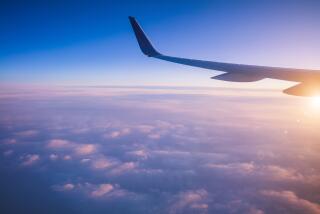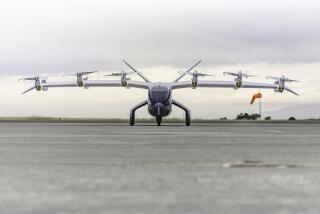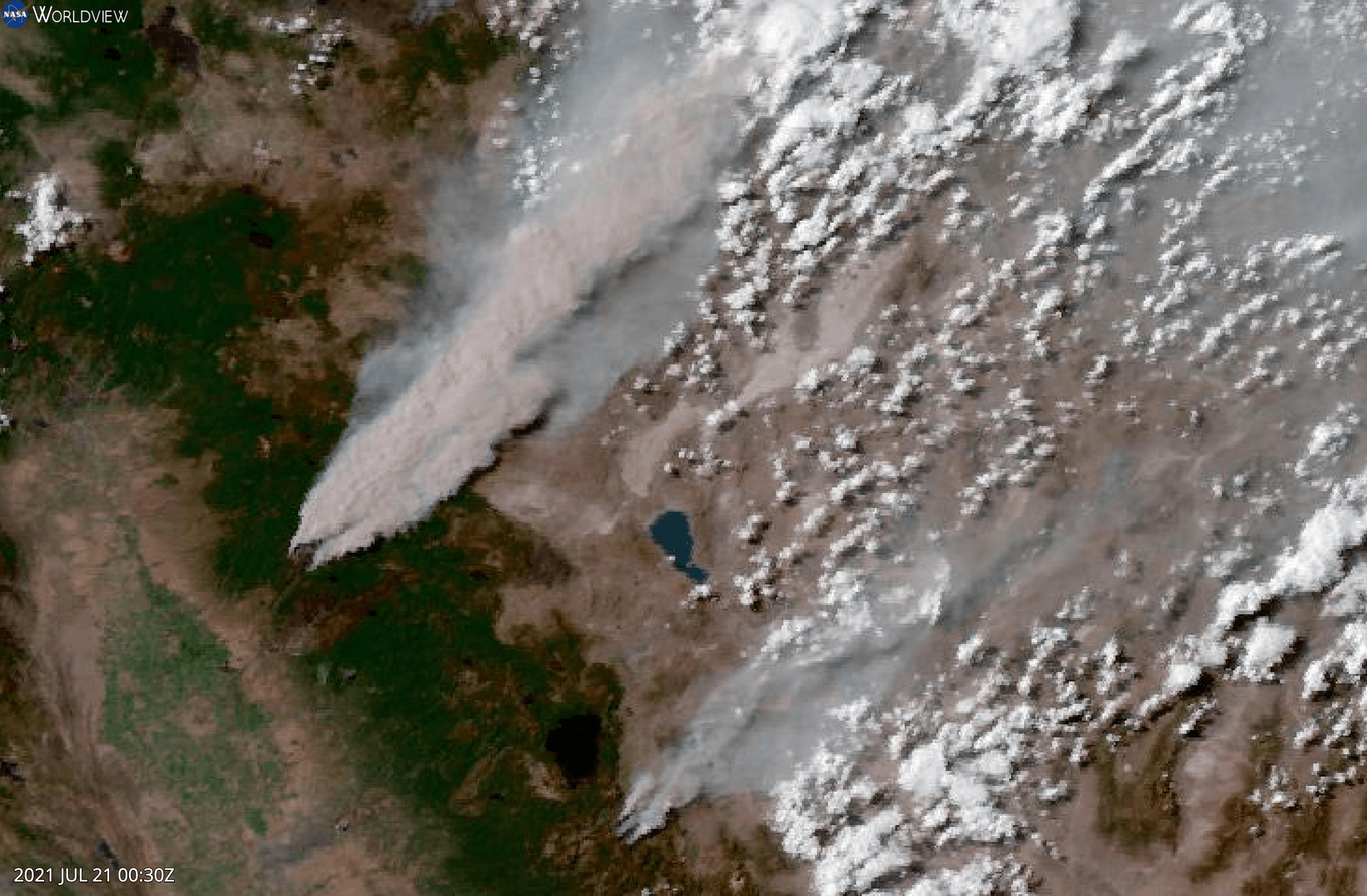Carpool lanes for airplanes?
Concealed under a thick blanket of fog, Louisville International Airport emitted an eerie orange glow as Capt. James Haney lined up his heavy cargo jet for landing after a long nighttime flight from Los Angeles.
As he descended, the United Parcel Service captain had an advantage other pilots don’t have: a monitor in the dashboard that displayed a clear picture of aircraft plying the soupy skies around him, guiding him safely around a stream of other planes arriving from the West Coast.
After the Boeing 767 touched down, with a Times reporter observing in the cockpit, the satellite-based surveillance system helped Haney avoid nearby aircraft hidden behind the unusually heavy white mist.
UPS Airlines is pioneering the system in Louisville in hopes of using its breakthrough technology to safely land more airplanes per hour and prevent delays. More significant, the system, which relies on a network of global positioning satellites commonly used by hikers and drivers, also is the backbone of an ambitious plan by federal officials to overhaul the nation’s aging air traffic control system.
The 1950s-era network is in dire need of a technological overhaul as passenger traffic is expected to jump 78% to nearly 1.3 billion annually by 2025. But modernizing highways in the sky with a precise satellite-based system carries a staggering $40-billion price tag, and the Federal Aviation Administration has yet to persuade Congress and the airlines to help pay for it.
Advocates say the proposed modernization — which includes satellite technology along with a system that would allow public agencies and private airlines to share information and new navigation procedures — is expected to improve efficiency and increase safety.
Federal officials plan to use signals from satellites to create something akin to carpool lanes in the skies for airlines that equip their aircraft with the new technology.
Last year was the worst in history for flight delays, with planes stranded on the ground for hours in well publicized incidents in Texas, Colorado and New York. Although inclement weather played a major role, carriers complain that the patchwork of technologies that make up the existing air traffic network contributes to severe delays.
On Friday, airlines grappled with thousands of delays along the East Coast when a computer system that processes pilots’ flight plans went down. A backup system also failed. The malfunctions, exacerbated by bad weather, required controllers to enter information manually and caused some passengers to wait up to four hours for their flights.
FAA officials attributed the glitch to 1960s-era technology that “reflects the need for the modernization of the air traffic control system.”
But much about a plan to revolutionize the nation’s aviation system is up in the air. A coalition of federal agencies that is designing the system is attempting to persuade Congress to authorize funding for the overhaul and cash-strapped airlines to equip their fleets with new technologies. And not everyone is convinced the new system will live up to expectations.
“Right now, I have to prove this is going to work,” said Vinnie Capezzuto, manager of the FAA’s surveillance and broadcast services program. “We can’t afford not to do it.”
Aviation experts say it may be tough to convince Congress — and the flying public — that the upgrade is necessary, given that many passengers assume today’s system — which serves half of the world’s air traffic — is adequate.
“The good news is that accident rates are very low now,” said John Hansman, director of the International Center for Air Transportation at the Massachusetts Institute of Technology, “but we’ve run into an era where it’s hard to have a sweeping demand for change.”
Hansman noted that, historically, it has taken a catastrophic accident to provide the impetus for major change.
A midair collision between two airliners over the Grand Canyon in 1956, in which 128 people perished, convinced Congress it must fund an air traffic system that would allow more precise tracking of aircraft by radar. Until the accident, pilots and controllers relied on rudimentary radio communications and a “see and be seen” philosophy to guide aircraft through most of the nation’s air space.
The FAA says the proposal for the nation’s “next generation air transportation system” will transform air travel, as the “Internet changed computing,” in part by replacing antiquated ground-based radar systems with more accurate and reliable satellite technology. The agency hopes Congress will make a funding decision this fall.
The existing system requires pilots to fly a network of rigid routes, often not the most direct paths, over navigational aids on the ground. The system relies on radar, which uses radio beams to scan the sky for objects to determine an aircraft’s location.
Because it takes as long as 12 seconds to update information on radar scopes, air traffic controllers must separate aircraft by several miles to make up for the imprecision. The system also doesn’t allow pilots to see the location of other planes. Nor does it cover oceans or high mountain ranges.
Global positioning satellite technology, however, updates information to controllers every second, allowing pilots to fly more direct routes. Known as automatic dependent surveillance-broadcast, or ADS-B, the technology also would allow pilots to see what planes are around them, how fast they are flying, their flight numbers and their headings. Officials say the ground infrastructure required to operate the technology would be cheaper than radar to install and maintain.
Pilots say ADS-B also would include airfield maps, allowing them to see aircraft, as well as vehicles, operating around them on the ground, helping to reduce near misses. Pilots now must rely on controllers to warn them when other planes are approaching them on the ground.
“You can have a brand new Boeing 777 and yet still have to rely on a piece of paper and a compass” to find your way around on the airfield, said UPS’ Haney. “This system is going to save lives. There’s very little question right now that the most dangerous place to be in an airplane with the motor on is on the ground.”
Among the challenges in replacing radar with ADS-B is how to equip aircraft with technology that can receive signals from global positioning satellites. Airlines say they are reluctant to pay millions to retrofit planes.
“What we see is a cost on the airlines’ side and most benefits on the FAA side,” said Basil Barimo, vice president of operations and safety at the Air Transport Assn. of America, a national airlines trade group.
“If the FAA came out today and put a mandate forward and said, ‘ You have to go equip your fleet, ‘ the airlines would push back,” he said.
The FAA this fall will propose requiring carriers to install ADS-B in their fleets by 2020 if they want to access what the agency calls high-occupancy vehicle lanes — or more direct routes — in the sky. It will make a final decision by 2010. The agency also plans to award a contract in August to install ground stations that will hand off signals from satellites to aircraft.
Carriers and the FAA agree that the full benefits of the system will not be realized unless most aircraft are equipped with it.
“In order for it to work really well, we need to have everybody, or almost everybody, equipped,” said MIT’s Hansman. “If half the people do and half the people don’t, it becomes very hard to increase the performance of the system.”
Some aviation industry experts question whether the agency has done sufficient planning to ensure the satellite system and other technologies proposed by the FAA will succeed. The agency has tried unsuccessfully in the past to overhaul the complex air traffic control network.
“It’s like a play that’s come back to town,” said Ken Mead, a lawyer in Washington, D.C., and former inspector general of the Department of Transportation. “I’m anxious to see the efficiency case for ADS-B. I don’t think the case has been made that it really will speed up air traffic control.”
The FAA also must rewrite procedures controllers use to guide aircraft and redesign the airspace to establish the high-occupancy lanes. Experts also worry what would happen if a sunspot or other anomaly took down the satellite network. The FAA says it will keep some radar systems in place as a backup.
Pilots and controllers who participated in ADS-B tests, particularly in Alaska, also point to a steep learning curve for controllers who will use the system. But they add that the system’s safety benefits alone are worth it.
In Alaska, where the geography prevents wide use of radar, the FAA equipped 200 general aviation aircraft with ADS-B technology and installed receivers on the ground to intercept the signals. The new system halved the accident rate in five years. Because it gives each aircraft its own identifier, ADS-B also helped rescuers find planes that crashed in remote locations.
ADS-B also prevented accidents in Florida, officials say. Embry-Riddle Aeronautical University in Daytona Beach equipped 65 propeller planes with the system after student pilots repeatedly got too close to one another during training, averaging 10 close calls in the air a month.
“ADS-B provides a high level of comfort because a pilot has a picture of what’s around their airplane,” said Frank Ayers, chairman of the university’s flight training department.
“After we got ADS-B on board, the midair collision reports went down to almost zero,” he said.
As part of a test program, helicopter operators and the FAA plan to install the system on helicopters and oil platforms in the Gulf of Mexico. They hope it will help helicopters ferry workers to oil rigs safely during inclement weather.
Pilots and controllers now rely in large part on spotty radio communications. Officials plan to award a contract to build the ADS-B system, which also will serve high-altitude commercial flights, this year.
“We want to establish what will be like an HOV lane for anybody that is equipped,” said Robert Novia, an FAA manager in Houston who is working on the gulf project. “They wouldn’t have to be with the rest of the airplanes and incur the kinds of delays and altitude restrictions that everyone else does.”
Aircraft at cruise altitudes over the gulf now must be separated by scores of miles because there is no radar coverage to tell controllers where they are.
UPS, the carrier that is trying out the technology in Louisville, is pressing the FAA and legislators to move more quickly to deploy ADS-B nationwide.
“In Kentucky we have a saying ‘I’m sitting on the front porch and fixing to do something.’ At some point you have to stop fixing and go to the mall,” said Capt. Karen Lee, director of flight operations at UPS Airlines.
“Implementation is only a political problem,” she added. “The technology is ready to go; we have to get past the resistance to change.”
jennifer.oldham@latimes.com
More to Read
Sign up for The Wild
We’ll help you find the best places to hike, bike and run, as well as the perfect silent spots for meditation and yoga.
You may occasionally receive promotional content from the Los Angeles Times.






